Alan Paul's Blog, page 38
January 18, 2014
TheDaily Mail UK headline reads: “China starts televising...
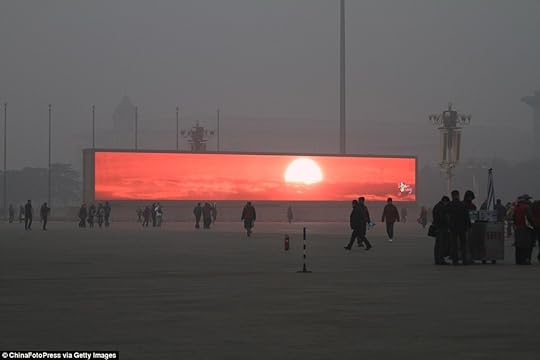 TheDaily Mail UK headline reads: “China starts televising the sunrise on giant TV screens because Beijing is so clouded in smog.” Accompanying photo on the left. I poked around trying to find some evidence it was a fake to no avail.
TheDaily Mail UK headline reads: “China starts televising the sunrise on giant TV screens because Beijing is so clouded in smog.” Accompanying photo on the left. I poked around trying to find some evidence it was a fake to no avail.
You won’t be surprised by this if you read Big in China or have listened to “Beijing Blues,” the first line of which is, ”They say the sun is shining but I don’t see it anywhere.”
I will be very happy when that’s all old news. In the meantime, read the Big in China excerpt below and check out Woodie Alan’s signature song, “Beijing Blues.”
From Big in China, Chapter 23, You Ain’t Going Nowhere:
I never could have made a long-term commitment to living in China, however, because of the pollution, which could be mind-bendingly bad. Rapid economic growth spurred massive construction and an explosion in car ownership, overwhelming other improvements and keeping the air a thick stew of particles and pollutants.
We always knew what we were getting into; a few days into our look-see visit, the skies became hazy and the air began to smell. The “fog” grew for two days until we couldn’t see the high-rise construction project outside our hotel-room window. “It’s good that you’re seeing this,” our guide said. “The pollution’s
not like this all the time but it does happen regularly and you should know that.”
We were too excited to pause and really contemplate the potential health effects on our whole family. That lack of attention sometimes seemed foolish. I often saw a brown mist hovering above the city when I flew in to Beijing, even on days that were crisp and blue on the ground. Many people complained about a “Beijing cough” that lingered for weeks. If we didn’t ride our bikes for a few days, we would find them covered in dust and dirt. The school kept kids indoors on particularly bad pollution days, and Eli looked outside one nasty day and said, “Aw, today’s not going to be any fun. It’s too foggy to play outside.”
Spring sandstorms were also regular occurrences, sometimes mixing with light precipitation to rain mud from the sky. It didn’t rain actual water for our first eight months in Beijing until the sky opened for a thirty-hour drenching that evoked Noah. It felt like a rebirth afterward, with everything looking
and smelling fresh and clean. The city had taken a shower, washing away a heavy layer of grime. I stepped out onto our third-floor balcony and stared dumbfounded at mountains gleaming on the horizon, visible for the first time. A sunset-painted sky reflected off ranges to the north and west, creating a vastly different landscape.
After a couple of atrocious pollution days a friend told me that she had heard of someone finding out that their lungs had been damaged by years of living in Beijing. “Living here is like smoking a pack of cigarettes a day, you know,” she said.
That sounded like an urban legend, but I couldn’t shake the thought, so I asked my radiologist father-in-law to take a chest x-ray on our next visit. The good news was that my lungs looked perfectly normal. The bad news was that they would have looked the same if I actually had started smoking a pack a day two years prior.
“Smoking causes cumulative damage and it probably wouldn’t show up in that short a time,” he said.
There was no way to measure the damage that breathing in Beijing had done to any of us, but there was certainly reason to worry. The Asian Development Bank released statistics showing that Beijing had the dirtiest air of all major Asian cities, with a pollution level seven times higher than what the World Health Organization had deemed safe. I could sometimes feel the pollution in my lungs and in my eyes, as my contacts fogged up.
I spoke to an American environmental expert based in Beijing who said simply, “When it looks really bad outside, it’s really bad.” Still, she urged me to not overthink the problem, insisting that the air was no worse than it had been in the United States or Europe forty years earlier.
“Air pollution is a real problem here, but I think it’s a disproportionate expat concern compared to all the other risks they take every day,” she said.
She was talking about driving, which was a valid point, except that driving was optional, and breathing was not.
Excerpted from Big In China: My Unlikely Adventures Raising A Family, Playing The Blues and Becoming A Star in China (Harper). Available now in all formats. Copyright 2011 by Alan Paul.
January 17, 2014
Charles Shaar Murray on One Way Out

 “Like a master bandleader, Alan Paul orchestrates a bluesy, jazzy, rocking chorale of voices telling the tale of a brotherhood under stress and a band who got what they hardly realized they wanted, lost what they had and fought a decades-long struggle to get it back.”
“Like a master bandleader, Alan Paul orchestrates a bluesy, jazzy, rocking chorale of voices telling the tale of a brotherhood under stress and a band who got what they hardly realized they wanted, lost what they had and fought a decades-long struggle to get it back.”
—Charles Shaar Murray, author of Crosstown Traffic: Jimi Hendrix & The Post-War Rock ‘N’ Roll Revolution and Boogie Man: The Adventures of John Lee Hooker in the American Twentieth Century
I was honored that Charles Shaar Murray agreed to read an early edition of One Way Out: The Inside History of the Allman Brothers Band and very, very pleased that he liked it. If this sounds repetitive to what I have said about Anthony DeCurtis and Ashley Kahn… well, I didn’t ask writers I didn’t really respect for blurbs! Why would I care what they think?
One of my first jobs at Guitar World when I became Managing Editor in 1991 was working with Charles on a review he wrote for us of Eric Clapton’s multi-night run at the Royal Albert Hall featuring Buddy Guy, Eric Clapton and others. The brilliant Crosstown Traffic was a new book which transfixed me and it was a treat to work with him. On a subsequent junket to London I spent a great time with CSM playing his vintage Strats and drinking iced vodka at his pad, er flat…
The wonders of Facebook brought us back together.
// ]]>
Amazon.com Widgets
January 8, 2014
Warren Haynes and Derek Trucks to leave the ABB at end of the year.

Beacon rehearsal, 2007. Foto by Kirk West
It’s been speculated for a while, but Butch Trucks spilled the beans on the Jam Cruise that his nephew Derek would be leaving the Allman Brothers Band at the end of the year. As word began to circulate, Derek and Warren Haynes released both joint and personal statements about the situation. See below. Wow. End of an era. I am still digesting this news myself and it is shocking even if it is not surprising. Very happy that I will be at the Fox in Atlanta on Friday night when the Brothers perform at All My Friends, the tribute for Gregg Allman. It also should make the upcoming Beacon run extra epic.
No word yet from the band, but it’s coming soon. Derek has been with the band since 1999. Warren has been with the band since 1989, with a hiatus from ’97-2001. They have been the frontline since Dickey Betts’ acrimonious departure – starting with the Beacon in 2001. They have provided me with many, many hours of happiness and musical fulfillment.
JOINT STATEMENT:
“For 25 years and 15 years respectively, we’ve had the honor and pleasure of playing, living, learning, and traveling with the Allman Brothers Band, one of the truly legendary rock and roll bands. We will be forever grateful for the opportunity and the experience, and for the love, enthusiasm, and support of the incredible fans. We are both preparing to dig even deeper into our various creative and musical endeavors and, as a result, 2014 will be our final year as part of the band. We are looking forward to seeing our loyal ABB fans at the Fox Theatre in Atlanta this Friday night January 10th and in March at the Beacon Theater in New York City as we celebrate the 45th Anniversary of the band.” - Warren Haynes & Derek Trucks
A Statement from Warren Haynes:
“I joined the Allman Brothers Band in 1989, at age 28, for a reunion tour with no promise or expectations of it going any further. Based on the success of the tour and the uncanny chemistry between the original members and the new members, we decided to continue and see where it all led. Now, here we are, 25 years later, and it has been an amazing experience. I’ve always said that if I were to join a band that I grew up listening to the ABB would be at the top of that list. The original version of the band was a huge influence on me and I’m sure that the countless hours I spent listening to and studying that music helped shape me as a musician. As proud as I am of being a member of such a legendary band, I’m even more proud of the music that we’ve made together and of being a part of carrying their original vision into the future.
As someone who’s been fortunate enough to juggle a lot of musical projects and opportunities I look forward to maintaining a vigorous schedule which will include many more years of touring and recording with Gov’t Mule in addition to my solo projects and to enjoying more family time as well. Being part of the ABB has opened a lot of doors for me and that’s something I don’t take for granted nor do I take for granted the friendship and musical relationships I have with each of the members. The 45th Anniversary of the ABB is a milestone amidst too many highlights to count and I’m looking forward to an amazing year creating music that only the Allman Brothers Band can create.”
[image error]
Susan and Derek. Photo by Kirk West.
A Statement from Derek Trucks:
“I got the call to join the Allman Brothers while on tour with my own band at the age of 19. It was out of the blue and felt surreal. I leapt at the chance. This was the music that I had cut my teeth on and it was the distinctive sound of Duane’s guitar that inspired me to pick up the instrument in the first place.
When I started with ABB I didn’t know how long it would last, only that I would let the music lead me and teach me. Amazingly that led me past the band’s 40th anniversary, to the band’s 45th, and now my 15th year as a member of this incredible band. Five years ago the 45th seemed like a lofty goal but I thought if we could make it to that milestone it would be a logical time to move on.
While I’ve shared many magical moments on stage with the Allman Brothers Band in the last decade plus, I feel that my solo project and the Tedeschi Trucks Band is where my future and creative energy lies. The Tedeschi Trucks Band tour schedule keeps growing, and I feel the time has finally come to focus on a single project, which will allow me to spend that rare time off the road with my family and children. It’s a difficult decision to make, and I don’t make it lightly.
I’m proud to have made a small contribution to the masterful music they have created over the past forty years, and will continue to create. Now seems like a good time to go out on a high note with a great 45th anniversary in 2014, and the mutual respect and friendship of the other 6 members of ABB.”
The Allman Brothers Band next plays at the Fox Theatre in Atlanta, GA on January 10th. I will be there.
Beacon run commences on March 7. I will be there.
January 7, 2014
George Lange and the Unforgettable Photograph on CBS This Morning


While I was zipping around the Holy Land, my old friend and neighbor from both Pittsburgh and Maplewood George Lange was featured on CBS This Morning talking about his book The Unforgettable Photograph: 228 Ideas, Tips, and Secrets for Taking the Best Pictures of Your Life and giving some practical tips about taking great pictures. George is a brilliant photographer and a deep, creative thinker, which is only hinted at in the CBS interview below, which is more oriented towards News You Can Use – and is quite useful in that regard.
I wanted to formally interview him, because I’ve always enjoyed talking to him so much, and did so last month for WSJ speakeasy: My interview with George is here.
January 6, 2014
Awesome interview with 15 y.o. Derek Trucks at the Big House
My old buddy E.J. Devokaitis interviewed 15-year-old Derek Trucks in Duane Allman’s bedroom at the Big House for Public Access TV in 1995. The last seven minutes feature the Derek Trucks Band circa 1995. EJ posted this now in spite of some embarassment. I think he has nothing to feel bad about. This is awesome all the way around, including the guest appearances by Kirk West in most of the ads. I’m so glad I made it to Macon during this fun era.
The Big House was the private residence of Kirk and his lovely wife Kirsten at the time. Rebecca and I visited them there in 1993. EJ was living at the BH and I think it was the first time we met. Below the interview, please see a pretty classic photo of my lovely wife and I belting it out at Gregg’s Hammond B3. Good times.
I spent a lot of time at the Big House, which is now an official Museum, and in the archives there while researching One Way Out: The Inside History of the Allman Brothers Band. E.J., then the curator and director, was a tremendous help.

Lovely wife and I on Gregg Allman’s Hammond B3, Big House, Macon, GA, 1993. FOTO by Kirk West.
December 23, 2013
Randy Poe on One Way Out: “Brilliantly detailed.. innovative…”


“Alan Paul’s One Way Out is a brilliantly detailed all-access pass to the Allman Brothers Band. Using his numerous personal interviews with the band members themselves—both past and present—as well as an almost endless entourage of friends, family members, roadies, managers, promoters, booking agents, record label executives, and fellow musicians, Alan Paul has successfully created the definitive ABB biography.”
—Randy Poe, author of Skydog: The Duane Allman Story
December 16, 2013
Billy Gibbons Reads One Way Out

Billy with the ABB, Beacon 2009. FOTO BY KIRK WEST
As Billy Gibbons prepares for a rare club gig this Weds. night at B.B. King’s in Manhattan:
“With this fine work, Alan Paul accomplishes the admirable feat of delving the depths of the Allman Brothers, a great aggregation of talent and artistry. He puts together the sweeping picture of how these gifted individuals with their special Southern stylishness created something utterly unique to the world. Rock on.”
—Billy F Gibbons, ZZ Top
By the way, no one has ever seen these photos, by the great Kirk West, One Way Out photo editor.
Billy was an obvious guy to ask for an advance quote for One Way Out: The Inside History of the Allman Brothers Band. He loves the Allman Brothers; he and Duane played gigs together; and admired on another’s playing – and guitars. Billy even wrote an foreword for Randy Poe’s excellent Skydog: The Duane Allman Story.
I’ve known Billy for decades and have interviewed him many times. He graciously gave me a great quote about Beijing Blues after being genuinely tickled to hear about my experiences in China: “Best Chinese blues I’ve ever heard. Who knew?”
I sent Billy an advance copy of One Way Out, emailed a bit with him and his publicist and then got radio silence. With deadline approaching, I reached out again and let him know. He emailed me back and I explained what I was looking for. That night, my phone rang at 12:04 am. I was deeply asleep and had forgotten to turn my ringer off – which I almost never knew.
I answered groggily and heard this: “Gibbons. Sorry for the late hour of this ring. I’d love to discuss your fantastic book now if it’s ok.”
Well, of course it was ok! I stumbled upstaris to my office and we chatted for about 15 minutes. I was really touched by how much Billy liked the book and some of the questions he asked. Then he said, “Ok, this chat was very helpful. I’ll have something to you tomorrow. And on a personal note: congratulations on a fantastic piece of work.”
Yes, that meant a lot to me. The next day I got another email from Billy, with the quote at the top of this page.
ALL PHOTOS BY KIRK WEST AND NEVER PUBLISHED
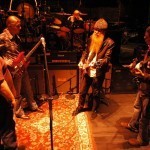
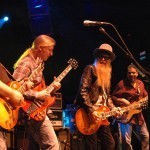
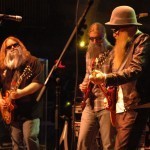
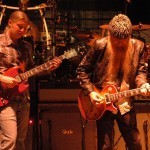
December 14, 2013
Warren Haynes on his Jerry Garcia tribute & Gov’t Mule’s Shout!
“No journalist knows the ins and outs of the Allman Brothers Band better than Alan Paul.”
-Warren Haynes, speaking about One Way Out: The Inside History of the Allman Brothers Band
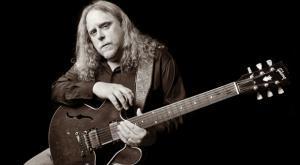
Photo by Ken Settle
This weekend is Warren Haynes’ 25th Annual XMas Jam in his hometown of Asheville, NC. I was supposed to be there and am very sad that I couldn’t be. Gregg allman, Gov’t Mule, Widspread Panic, Phil and Friends are amongst the performers, over three nights. The events have raised well over $1 Million for Habitat for Humanity. Great stuff all around. In honor of this event, I present my last Guitar World interview with Mr. Haynes, focusing on Gov’t Mule’s Shout! and his symphonic performances of Jerry Garcia music.
I’ve interviewed Warren too many times to count, but this one was special. It was my first visit to Red Rocks – long, long overdue! I was thrilled to be there, thrilled to see my old friend and one of my musical heroes in such a hallowed place, thrilled to be with my nephew Jesse Paul. Just a very cool, very special night for me.
Warren will be reprising the symphonic Jerry at least two more times – May 13 and 14 at Boston’s Symphony Hall with the Boston Pops.
**
Red Rocks is a musical mecca, a natural amphitheater in the foothills of the Rockies renowned for its great sound and serene setting. On this summer night, afternoon storms have given way to sunshine. A rainbow spreads across the plains behind the stage, helping to make the place feel even more magical.
On the stage, flanked by massive slabs of red rocks, the Colorado Symphony is taking its place, the black-clad musicians ambling out to their seats with instruments in hand. It’s an unusual setting for an orchestra—and an unusual crowd for one.
The steep rows of seats are filled with longhaired fans wearing Grateful Dead and Allman Brothers T-shirts. They’re buzzing with anticipation, and maybe a little something else, too.
The conductor strides outs with a wave and takes his place in front of the musicians, with his back to the audience. Behind him, a trio of more casually dressed musicians shuffle out and take their places: drummer Jeff Sipe, bassist Lincoln Schleifer and, at the lead, guitarist Warren Haynes, who is grasping Jerry Garcia’s iconic custom-made Wolf guitar. Built for Garcia by luthier Doug Irwin in 1972 and 1973, Wolf was one of the Grateful Dead leader’s main guitars. It sold for $789,000 at auction in 2002, and its appearance here tonight is indeed special.
With a smile and a wave, Haynes is ready for business. The orchestra launches into the show’s overture, a sweeping, majestic take on the Grateful Dead’s psychedelic masterpiece “Dark Star.” It must have been precisely what Jerry Garcia’s family had in mind when they commissioned Haynes to pick material and work with arrangers to craft this unique tribute to the late guitarist.
A couple of hours later, after playing 19 Garcia songs both iconic and underground, Haynes stands in front of his dressing room in the cave-like basement backstage, shaking hands and exchanging pleasantries with orchestra members. Around the corner, small plaques mark every concert ever held at the venue, going back to 1947.
Haynes has been playing here since 1989, appearing with the Allman Brothers Band, Gov’t Mule, the Dead and Phil Lesh and Friends. A decade ago, he even received a trophy from the Red Rocks promoter after he appeared at the venue eight times with three bands in one summer. However, this is the first time Haynes has ever fronted an orchestra, and who’s to say what may come next for the prolific guitarist. After all, Haynes has always been open to musical exploration.
As a case in point, look no further than Shout!, Gov’t Mule’s new, 10th studio album and their first for Blue Note Records. It’s the band’s first new recording in four years, coming on the heels of a yearlong hiatus, the first of the band’s almost 20-year career.
Featuring Haynes, drummer Matt Abts, bassist Jorgen Carlsson and keyboardist/guitarist Danny Louis, Shout! is a diverse album. Its songs range from the punchy, new wave–inspired “Funny Little Tragedy” to the album-closing guitar jam of “Bring on the Music.” This stylistic breadth is reflected in the range of guest singers who appear on the accompanying bonus disc, where they deliver their own takes on the album’s songs. Among them are Dave Matthews, Steve Winwood, Jim James, Elvis Costello, Ben Harper, Grace Potter, Myles Kennedy, Glenn Hughes and Dr. John.
Clearly, Haynes’ career is anything but predictable. As he settles into his dressing room at Red Rocks after the concert, Guitar World takes the opportunity to talk to him about these new projects and what’s ahead for him and the long-running Gov’t Mule.
How did this symphonic exploration of the Grateful Dead’s music come about?
Jerry’s people called to say they had an idea about putting on some performances with symphonies playing Jerry’s music. They asked me to be involved as the first guest artist. I picked the material and sent my arrangement ideas to three arrangers, who took it from there. I actually called Phil [Lesh, Grateful Dead founder and bassist] when it was time to pick arrangers and got his take on the concept and some help picking the arrangers. That’s his world. He knows more about classical music than anyone I know, and far, far more than I do.
Given your love of improvisation, performing with an orchestra must have been a special challenge.
Yes. I’m not used to doing anything quite so structured, but with a symphony that’s just the way it is. We were able to utilize the spirit of improvisation in three different ways. There are sections where the symphony will bow out and the electric band will improvise and the symphony comes back in on cue. Sometimes what the symphony is playing is orchestrated but what I’m playing on top of it is complete improvisation.
And the weirdest aspect, which I really love, is sometimes what the symphony is reading was originally improvised by the Grateful Dead, then orchestrated. For instance, the interlude of “Dark Star” that opens the show was arranged by Steven Bernstein based on a 1968 performance of “Dark Star” that I sent him. He took a four- or five-minute excerpt of it and arranged it for the orchestra, so everything they are playing was played by someone in the Grateful Dead as improvisation.
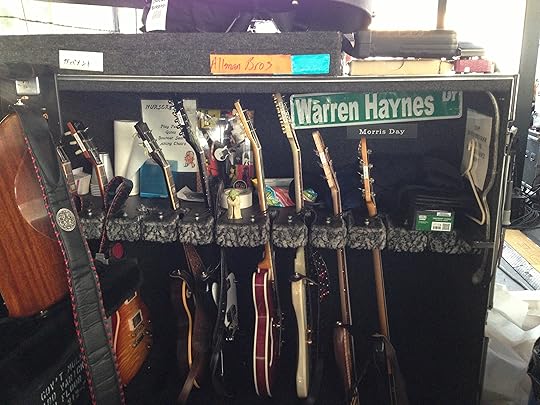
Warren Haynes’ Tools of the Trade, PeachFest 2013. Photo by Alan Paul
Was it hard to find the right guitar approach for this?
The biggest challenge is to be able to hear the symphony well enough to respond accordingly, because all of my soloing is based on what they’re doing. It’s made easier by the fact that I’m playing the Wolf, which instantly gives the sound that connects with this music. The owner of the guitar loaned it to me for the tour, and I got it the first day of rehearsal in Pittsburgh.
I was hoping I’d be able to play it for a few songs, but as soon as I plugged it in, I knew I wanted to play it all night. I just run it through my 1965 blackface Super Reverb. I borrowed a Mu-Tron [envelope filter] that I run through the effect loop in the guitar and control it the same way Jerry controlled his. Those are really the only two sounds I’m using: guitar straight in and guitar through the Mu-Tron. It just lends itself to that music. It’s very inspiring, and it makes me want to play more in that vein than I ever would otherwise.
Let’s talk about Shout! which is an unusual new direction for you. Where did you get the idea of having different vocalists record your songs and include it as a bonus disc?
The first three people I thought of were Elvis Costello for “Funny Little Tragedy,” Dr. John for “How Could You Stoop So Low” and Toots Hibbert for “Scared to Live.” I just heard those voices when I wrote those songs and thought of having them sing a cameo appearance. But that seemed underwhelming and like a lot of trouble to go through to have someone sing a small part of the song. So I started to think bigger.
Didn’t the actual process begin with a correspondence with Elvis?
Yeah. I wrote him an email asking for advice about recording the vocals for “Funny Little Tragedy,” which I wrote as a tribute to early Eighties British new wave. I had never sung a song that went this far in that direction and I wanted it to have that authentic garage-y sound, and he responded with a really nice, long email with what he used on all of his early albums, being very specific. Then he said, “You should just use something cheap, like a Shure SM58,” which I did, and it turned out great. But that planted a seed in my head: “It sure would be cool to hear him sing that song.” That seed blossomed into the entire bonus disc.
Very few people would associate you with Elvis Costello. Has he always been a significant influence?
He became a bigger influence over the years. I think he’s consistently written amazing songs, which is very impressive and really quite rare. From a compositional standpoint, there’s so much that can be learned listening to his work from the beginning to now, and I think it’s so important to break new ground and not just keep going back to the same well. That applies to guitar playing, to singing and, probably most of all, to songwriting.
As a guitarist, do you still feel like you have something to prove? Does being so well established give you license to not burn on a song?
I think on this album you probably get more different angles of my guitar playing, which is just a reflection of the diversity of the songs and what they demand of the guitar player. I’ve never believed in forcing myself on the song. There has to be a balance between respecting the song and inflicting your personality upon it.
Danny Louis played the [guitar] solo on “Funny Little Tragedy,” because what he played was more appropriate than anything I would have come up with, because his style is more aligned with that genre. We recorded that live, and his solo is off the cuff. I’m playing a PRS baritone guitar on the left side, and Danny’s playing a Strat on the right side. I caught him off guard by looking at him and saying, “Danny Louis,” and having him solo.

Longtime Haynes guitar tech Brian Farmer readies PRS baritone at 2013 PeachFest. Photo by Alan Paul
Is there more baritone guitar on this album than on your previous releases?
Yes. It’s also the primary guitar on “No Reward” and “Scared to Live.” The funny thing is, after we finished these sessions, we flew down to Little Rock for a festival and Staind were on the bill. We were on the same flight back and I ended up sitting next to the guitarist, Mike Mushok. We started talking shop and I told him about this, and he goes, “That’s my signature guitar!” I only knew it was a PRS baritone. Small world.
What else did you play?
“World Boss” is an Epiphone solidbody that was hanging in the studio that I tuned down a half step. “Forsaken Savior” is my 1961 335 with a capo on the second fret. “Done Got Wise” is the most interesting song. I wrote it with a guitar tuned to an E7 tuning that I discovered by mistake. I was trying to tune to an open E and had not yet tuned the D string to an E. I started playing and it sounded really cool. Jorgen was sitting across from me and I started playing a bunch of slide chordal ideas in this crazy tuning, and it sounded really cool. So for the recording, I tuned an Epiphone 12-string to E7.
It’s very bizarre and has a very Zeppelin-y sound, but to the best of my knowledge [Jimmy] Page never used that—nor did anyone else that I’m aware of. As a result, I had to overdub the solo. It would have been impossible to improvise a solo in that tuning. It made it fun to play a solo. I had to listen really closely because the dominant seven in every chord had its own melodic slant I had to work around. It was a cool challenge. Other than that, there’s a lot of my signature Les Paul on the record.
Yet your guitar sound is different.
Most of the guitar sounds are my 1969 100-watt Marshall “Plexi” that I haven’t used in a long, long time. We basically set up a cool clean sound with it and a cool dirty sound. We still used my Diaz for some of the more Fendery-sounding stuff and a Super Reverb in a couple of places.
I usually go in with a bunch of amps, run them all together, mic them and decide what’s working and what isn’t so we can audition them as we’re going song for song. This array usually includes a small amp like a Fender Pro Jr. or a Gibson Skylark, sometimes at my feet like a monitor. The 4×12 cab is usually in another room, but on the stuff where I’m getting feedback and playing long solos live on the track, I had it in the room behind me, and it was so loud I had to keep cranking the headphones up to get the band up above the Marshall. You need to have the feedback on your back if you’re going to manipulate it.
It’s rather amazing that you play most of your solos live on the rhythm tracks.
Every time we do a record I think, Next time I will overdub more so I can experiment more. But I always end up keeping the solos that I play with the band, because that’s ultimately what I prefer: the interplay among all of us. As much as I love the challenge of playing differently, the collective improv thing always seems to win out.
I did overdub a few solos, but the chemistry that I have with Matt, Jorgen and Danny is based on collective call and response. We’re all listening in a way that’s very jazz-like, and all four of us are always basing what we play on what someone else plays, so every take and live performance of a song will be different. We take that approach even with some of the simpler chord structures because I just find it more satisfying than everyone finding a part and sticking to it. The music I grew up loving was played that way, and it didn’t begin to change until the mid Seventies, which I think was to its detriment, because there was so much beautiful music made by taking that everyone-listening-to-everyone approach.

Gov’t Mule at PeachFest, 2013. Photo by Alan Paul
It’s been four years since the last Gov’t Mule album. A lot of water has passed under the bridge since then. Do you think that all factored into this album sounding quite different from anything you’ve done?
A lot of factors played into the final result. We allowed ourselves to take a hiatus, and that year off helped us gain some perspective, look back on everything we’ve done and figure out what kind of record we wanted to make. This is our most diverse record, and I don’t think we could have done it 10 years ago.
Each song we brought to the table had it its own personality; it sounded like Gov’t Mule but didn’t sound like anything we had ever done, which helped the overall flow and kept the process moving forward. Next year we are celebrating our 20th anniversary, so I think it’s appropriate to shine a light on as many influences as possible and how much we’ve grown over the years. It took this long to have a license to release something this diverse.
Why did it take so long?
If this was our first or second album, it might be construed as too wide of a turn, but I think it makes perfect sense given the whole trajectory of the band. A lot of artists don’t take the risk of spreading themselves too thin because they’re worried that their audience won’t be accepting. With Gov’t Mule and myself, people knew from the start to expect the unexpected. And I think each record we’ve done has gone a little farther down that path.
December 13, 2013
Gregg and Warren: “These Days”
Gregg Allman and Warren Haynes acoustic duo. Jackson Browne’s “These Days”, XMas Jam Pre-Jam. 12-12-13. The Orange Peel. Asheville, NC
December 12, 2013
The Most Famous, Rare, and Valuable Guitars in the World


Hey, fellow guitar nuts. You need to check out this book: Guitar Aficionado: The Collections: The Most Famous, Rare, and Valuable Guitars in the World. From my good friends at Guitar World’s sister publication.
Support the printed word, folks. Guitar World has been very good to me for a very long time.
You can subscribe here:




